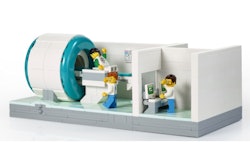
A Lego MRI scheme developed by a U.K.-based radiographer to reduce anxiety among children has now won the support of more than 5,000 followers. The Danish toy company is allowing the project leaders 14 months to reach the 10,000 supporters required for a commercial launch.
The halfway point for Lego open MRI was reached on 9 November, and a week later, the figure had jumped to 5,232, according to senior MRI radiographer Apollo Exconde, who created the product.
 The latest designs of the Lego open MRI include interchangeable coils. All photos courtesy of Apollo Exconde.
The latest designs of the Lego open MRI include interchangeable coils. All photos courtesy of Apollo Exconde."Lego open MRI has interchangeable coils and can now be transformed into other modalities using the same bricks," Exconde told AuntMinnieEurope.com. "I am still trying to create a video or photo shoot wherein the Lego open MRI is attracting metals as this design has a real functional magnet with an unknown tesla unit inside."
The latest model helps to explain what happens in the different stages of the MRI examination process and covers head, body, and coil placement. In addition, it can be modified to create upright MRI, CT, and dual-energy x-ray absorptiometry (DEXA) scan designs.
Coping with anxiety and claustrophobia
The overall aim of the initiative is to help to all kids who are curious and anxious about MRI scans, Exconde explained.
 Toys can help patients learn about MRI and lower their stress levels, says Apollo Exconde, originally from the Philippines.
Toys can help patients learn about MRI and lower their stress levels, says Apollo Exconde, originally from the Philippines.The model design was based on patients' suggestions and with children in mind, and it should be shown to children at the earliest possible stage so they know what will happen to them during an MRI scan. The end goal is to eliminate misconceptions or worries such as how far the child's head will go through the scanner, timings, etc.
"This will be amusing and interesting for everyone, and it's a perfect way to reduce anxiety and excite their hydrogen atoms before the actual scan," Exconde noted. "What separates this open MRI versus the conventional one is its wide, unobstructed view -- a perfect replica, while explaining about the scan to anxious patients."
If a patient is referred for an open MRI, it is because he or she failed to complete a scan in a conventional MRI unit, and if the same thing happens again because of claustrophobia, this will further delay treatment, he noted.
The model has a sliding table that shows where the patient's head and body will be, as well as what coil will be used and how the patient will be positioned.
"MRI is not only about the machine itself -- the coil is the piece that makes the pictures and [is] designed for each body part," Exconde said.
In the U.K., Sheffield and Birmingham Children's Hospitals have recently acquired Lego scanners to help patients understand the process of having an MRI exam and to reduce their stress and anxiety levels. Other hospitals, such as the Faculty of Health, Social Care & Medicine at Edge Hill University in Liverpool, reportedly prefer to use animation for this purpose and have developed a comic strip for children to read before coming to hospital.
For the most up-to-date description of Lego open MRI, you can go the organizers' website.



















